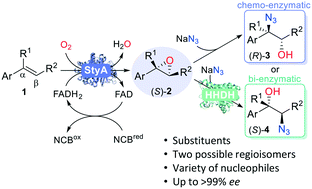Asymmetric azidohydroxylation of styrene derivatives mediated by a biomimetic styrene monooxygenase enzymatic cascade†
Abstract
Enantioenriched azido alcohols are precursors for valuable chiral aziridines and 1,2-amino alcohols, however their chiral substituted analogues are difficult to access. We established a cascade for the asymmetric azidohydroxylation of styrene derivatives leading to chiral substituted 1,2-azido alcohols via enzymatic asymmetric epoxidation, followed by regioselective azidolysis, affording the azido alcohols with up to two contiguous stereogenic centers. A newly isolated two-component flavoprotein styrene monooxygenase StyA proved to be highly selective for epoxidation with a nicotinamide coenzyme biomimetic as a practical reductant. Coupled with azide as a nucleophile for regioselective ring opening, this chemo-enzymatic cascade produced highly enantioenriched aromatic α-azido alcohols with up to >99% conversion. A bi-enzymatic counterpart with halohydrin dehalogenase-catalyzed azidolysis afforded the alternative β-azido alcohol isomers with up to 94% diastereomeric excess. We anticipate our biocatalytic cascade to be a starting point for more practical production of these chiral compounds with two-component flavoprotein monooxygenases.

- This article is part of the themed collection: Emerging Investigator Series


 Please wait while we load your content...
Please wait while we load your content...